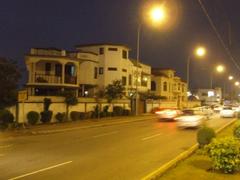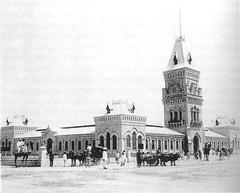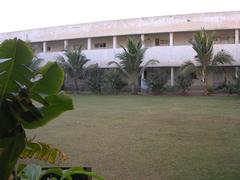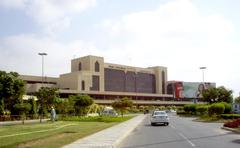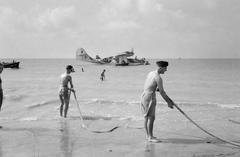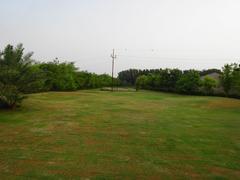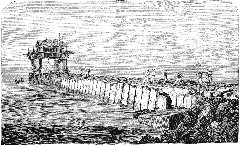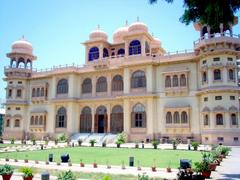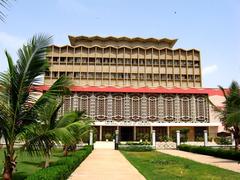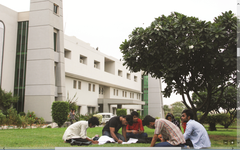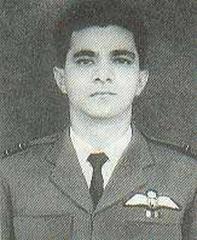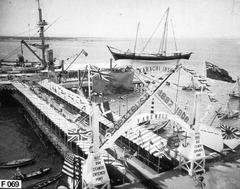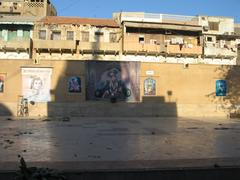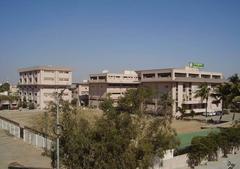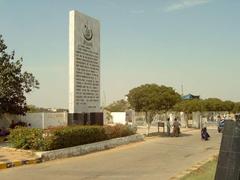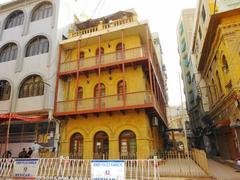Shahrah-e-Faisal Karachi: Visiting Hours, Tickets, and Complete Travel Guide
Date: 04/07/2025
Introduction
Shahrah-e-Faisal is Karachi’s most prominent urban artery, serving as a vibrant testament to the city’s historical evolution, cultural diversity, and economic dynamism. Spanning approximately 18 kilometers—from the city’s central business district near Karachi Port Trust to Jinnah International Airport—this bustling boulevard is a lifeline for over 250,000 vehicles daily. Originally constructed during the British colonial era and called Drigh Road, it played a strategic role in military and commercial logistics, later gaining even more significance after Pakistan’s independence. Renamed in 1977 in honor of King Faisal bin Abdulaziz of Saudi Arabia, Shahrah-e-Faisal reflects both close diplomatic ties and Karachi’s transformation into a sprawling metropolis (Trip101).
This comprehensive guide explores Shahrah-e-Faisal’s rich history, key landmarks, visitor information—including accessibility and travel tips—and its role as the backbone of Karachi’s transport network. It also addresses urban challenges such as congestion and pollution, outlines ongoing infrastructure upgrades, and provides practical advice for navigating this dynamic corridor (Think Transportation, Karachi Tourism).
Table of Contents
- Historical Evolution
- Urban Significance & Visitor Information
- Route Overview & Major Intersections
- Key Attractions Along Shahrah-e-Faisal
- Accessibility, Safety & Travel Tips
- Frequently Asked Questions (FAQs)
- Exploring Quaid-e-Azam Mausoleum
- Recent Developments & Infrastructure Updates
- Weather & Traffic Considerations
- Community Events & Religious Observances
- Visual Media & Resources
- Conclusion
- References & Useful Links
Historical Evolution of Shahrah-e-Faisal
Colonial Origins and Development
Shahrah-e-Faisal, formerly Drigh Road, traces its roots to the British colonial era. Constructed to connect the city center with Drigh Cantonment, it was vital for military and administrative movement, linking Karachi Port to the hinterland and facilitating the flow of goods and personnel (Trip101).
After Pakistan’s independence, Karachi became the capital, and Drigh Road’s importance surged. The influx of migrants and establishment of government institutions spurred rapid urbanization and commercial activity along this corridor.
Renaming and Modernization
In 1977, Drigh Road was renamed Shahrah-e-Faisal to honor King Faisal bin Abdulaziz of Saudi Arabia, reflecting the strong diplomatic relationship between the two countries. Since then, the road has undergone multiple expansions and infrastructural improvements, evolving from a colonial thoroughfare into a modern urban expressway, mirroring Karachi’s own transformation.
Urban Significance & Visitor Information
The Backbone of Karachi’s Transportation Network
Shahrah-e-Faisal is often called the “backbone” of Karachi’s transportation system (Think Transportation). It stretches from the central business district near Karachi Port Trust to Jinnah International Airport, passing through key commercial, residential, and institutional zones. It links major neighborhoods such as Saddar, Cantt, PECHS, Karsaz, and Shah Faisal Colony, and connects to other vital arteries including National Highway, Rashid Minhas Road, and Shaheed-e-Millat Road.
Economic & Commercial Hub
Lined with prestigious business centers, hotels, and institutions, Shahrah-e-Faisal is a magnet for economic activity. Notable establishments along its stretch include:
- Karachi Port Trust: A symbol of Karachi’s maritime heritage (Trip101)
- Jinnah International Airport: Pakistan’s busiest airport
- Major Hotels: Pearl Continental, Avari Towers, Regent Plaza, Mehran Hotel
- Healthcare Facilities: Jinnah Hospital, National Institute of Cardiovascular Diseases
- Military Installations: PAF Base Faisal, PNS Karsaz
- Commercial Complexes: Awami Markaz, FTC, and numerous office towers
Visiting Tips
- Visiting Hours: Shahrah-e-Faisal itself is accessible 24/7. For sightseeing and photography, early mornings or late afternoons offer the best light and lighter traffic.
- Entry Fees: No fees for the road. Some nearby museums or attractions may charge entry.
- Accessibility: Served by buses, ride-hailing services, and private vehicles. Sidewalks are present in some areas; pedestrians should exercise caution.
Guided Tours & Photographic Spots
Guided city tours often include Shahrah-e-Faisal, highlighting its historical and architectural significance. Best photographic locations include the Karachi Port Trust building, Frere Hall, St. Patrick’s Cathedral, and the Pakistan Air Force Museum. Modern commercial complexes and skyline views also make for excellent photo opportunities.
Urban Mobility & Public Transport
Shahrah-e-Faisal is a focal point for Karachi’s public transport, served by buses, minibuses, and ride-hailing apps. For smoother commutes, the city is considering a Bus Rapid Transit (BRT) system to address congestion (Think Transportation). The road’s capacity is frequently tested by heavy vehicle volumes, making it a microcosm of Karachi’s mobility challenges.
Route Overview & Major Intersections
- Starting Point: Bhutto Underpass (Hotel Metropole), gateway to Saddar and Karachi Cantonment
- Dr. Daud Pota Road Intersection: Access to commercial Saddar
- FTC Flyover: Near FPCCI; smooths traffic flow
- Shahrah-e-Quaideen Flyover: Connects to PECHS, SMCHS, and Tariq Road
- Tipu Sultan Flyover: For southern access towards the airport and Malir Cantt
- Baloch Colony Flyover: Connects to Shaheed-e-Millat Expressway, Defence View, DHA, Korangi, and Landhi
- Karsaz Road Intersection: Access to KDA Scheme 1, National Stadium, and PAF Museum
- Drigh Road Underpass: Links to Rashid Minhas Road
- Jinnah International Airport Intersection (Star Gate): Direct airport access and continuation to N-5 National Highway
Key Attractions Along Shahrah-e-Faisal
- Mazar-e-Quaid (Quaid-e-Azam Mausoleum): Honors Pakistan’s founder; surrounded by gardens
- Pakistan Air Force Museum: Features aircraft displays and historical exhibits (Wikipedia)
- Karachi Expo Center: Hosts exhibitions and cultural events
- Hotels & Shopping: Mehran Hotel, Regent Plaza, shopping centers, restaurants, and cafes
- Nearby Sites: Frere Hall, St. Patrick’s Cathedral, Pakistan Maritime Museum (Tourism in Pakistan), Clifton Beach, Dolmen Mall Clifton, Port Grand
Accessibility, Safety & Travel Tips
- Best Visiting Hours: Avoid peak traffic (7–10 AM, 5–8 PM)
- Public Transport: Well-served by buses, rickshaws, and ride-hailing apps
- Parking: Available near major hotels and attractions; limited during busy hours
- Pedestrian Safety: Use bridges and underpasses; remain vigilant due to fast-moving traffic
- Differently-abled Access: Some crossings may be challenging; plan ahead
- Weather: Rain and monsoons can impact travel—monitor updates and advisories
Frequently Asked Questions (FAQs)
Q: What are the visiting hours for Shahrah-e-Faisal?
A: The road is open 24/7. For sightseeing, daylight hours are best.
Q: Are there entry fees for Shahrah-e-Faisal?
A: No. Museums or other attractions along the route may have separate ticket policies.
Q: How can I get there by public transport?
A: Buses, minibuses, and ride-hailing services are widely available. The route is well-connected to major city hubs.
Q: Are guided tours available?
A: Yes, several city tours include Shahrah-e-Faisal and its landmarks.
Q: Is Shahrah-e-Faisal accessible for people with disabilities?
A: Some pedestrian bridges and crossings may be less accessible; caution and pre-planning are advised.
Exploring Quaid-e-Azam Mausoleum (Mazar-e-Quaid)
History & Cultural Significance
The Mausoleum, completed between 1948 and 1970, is the final resting place of Muhammad Ali Jinnah and a symbol of Pakistan’s ideals. Designed by Yahya Merchant, its white marble geometric structure and surrounding gardens are focal points for Independence Day and other national events.
Visitor Information
- Location: Near Shahrah-e-Faisal; accessible by public and private transport
- Hours: Daily, 9:00 AM – 7:00 PM (including public holidays)
- Entry: Free of charge; guided tours available through Sindh Tourism Department or local agencies
- Features: Peaceful gardens, evening light and sound show, graves of Fatima Jinnah and other leaders
Practical Tips
- Visit early or late afternoon for comfort
- Modest dress is recommended
- Photography allowed in gardens/exterior, not inside the mausoleum
- Wheelchair accessible with ramps and pathways
For directions and more, refer to Sindh Tourism Department and Google Maps.
Recent Developments & Infrastructure Updates
Shahrah-e-Faisal has seen major upgrades: new flyovers, underpasses, resurfacing, and advanced lighting. Conversion of key buildings (like a four-star hotel into the SIUT Trust Hospital) demonstrates Karachi’s adaptability and public welfare focus.
Weather & Traffic Considerations
Monsoon rains can impact travel. Stay updated on conditions, avoid standing near billboards/electric poles during storms, and adhere to safety guidelines. Authorities manage road closures during religious events (e.g., Muharram processions), so check for advisories.
Community Events & Religious Observances
Shahrah-e-Faisal regularly hosts processions, festivals, and public gatherings—well-managed with security and traffic plans. Respect local customs, especially during religious observances.
Visual Media & Resources
Enhance your trip by consulting official maps, virtual tours, and high-quality images of Shahrah-e-Faisal and its landmarks on Karachi tourism platforms.
Conclusion
Shahrah-e-Faisal is not just a road but the heartbeat of Karachi—connecting historic sites, business centers, and vibrant neighborhoods. As you traverse it, you experience Karachi’s evolution, economic vitality, and cultural diversity. Planning your trip with awareness of peak traffic, weather, and local events will ensure a rewarding journey through one of Pakistan’s most important urban corridors.
For real-time updates, guided tours, and exclusive travel tips, download the Audiala app and explore Karachi’s dynamic offerings.
References and Useful Links
- Trip101: Historical Places in Karachi
- Think Transportation: Feasibility Study of Shahrah-e-Faisal BRT
- Karachi Tourism: Route Guide and Attractions
- Wikipedia: Pakistan Air Force Museum
- Sindh Tourism Department
- Tourism in Pakistan: Pakistan Maritime Museum
For detailed guides and the latest updates on Karachi’s attractions, download the Audiala app and follow our social channels.
